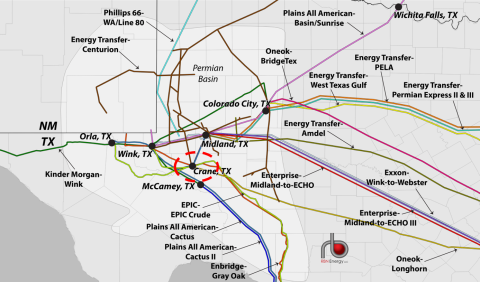Crane, TX, entered the 20th century with a population of only 51 people but a staggering 21,400 cattle and sheep, reflecting its ranching roots. Established as a railway station along the Kansas City, Mexico & Orient Railway (KCM&O) in 1911, Crane initially relied on ranching and the railroad industry. However, the discovery of oil in the Permian Basin in 1926 drastically shifted its economic landscape, turning Crane into a bustling oil boomtown. And that was just the beginning. In today’s RBN blog, we look at the central role Crane plays in bringing crude from the prolific Permian to the U.S. Gulf Coast.
Both Crane County and the city of Crane were named for William Carey Crane, a Baptist minister, editor and the founder of Baylor University. By the 1920s, the West Texas municipality had become a magnet for thousands of land speculators, workers and fortune-seekers, causing a rapid population surge, which peaked at 3,796 in 1960. Today, Crane remains a vital center for Crane County oil production. But Crane is much more than that — its inbound and outbound pipelines, storage facilities and interconnections now play a key role in moving Permian crude to market.
Figure 1. Permian Crude Oil Pipelines. Source: RBN Crude Oil Permian
So, how does the Crane area (dashed red oval in Figure 1 above) fit into the broader oil infrastructure context? Like Wink — but located further downstream and to the southeast — Crane’s significance stems from its role as a central hub for Permian oil transport. (Both hubs benefited from the same regional boom; for more on Wink, see Dream Baby, the first blog in this series).
Join Backstage Pass to Read Full Article









